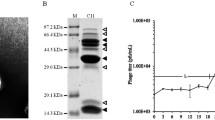Abstract
Temperate siphophages (MP29, MP42, and MP48) were isolated from the culture supernatant of clinical Pseudomonas aeruginosa isolates. The complete nucleotide sequences and annotation of the phage genomes revealed the overall synteny to the known temperate P. aeruginosa phages such as MP22, D3112, and DMS3. Genome-level sequence analysis showed the conservation of both ends of the linear genome and the divergence at the previously identified dissimilarity regions (R1 to R9). Protein sequence alignment of the c repressor (ORF1) of each phage enabled us to divide the six phages into two groups: D3112 group (D3112, MP29, MP42, and MP48) and MP22 group (MP22 and DMS3). Superinfection exclusion was observed between the phages belonging to the same group, which was mediated by the specific interaction between the c repressor and the cognate operator. Based on these, we suggest that the temperate siphophages prevalent in the clinical strains of P. aeruginosa represent at least two distinct heteroimmunity groups.
Similar content being viewed by others
Refrerences
Alonso A., Rojo F., and Martinez J.L. 1999. Environmental and clinical isolates of Pseudomonas aeruginosa show pathogenic and biodegradative properties irrespective of their origin. Environ. Microbiol. 1, 421–430.
Bondy-Denomy J., Pawluk A., Maxwell K.L., and Davidson A.R. 2013. Bacteriophage genes that inactivate the CRISPR/Cas bacterial immune system. Nature 493, 429–432.
Brussow H., Canchaya C., and Hardt W.D. 2004. Phages and the evolution of bacterial pathogens: From genomic rearrangements to lysogenic conversion. Microbiol. Mol. Biol. Rev. 68, 560–602.
Brussow H. and Hendrix R.W. 2002. Phage genomics: Small is beautiful. Cell 108, 13–16.
Cady K.C., Bondy-Denomy J., Heussler G.E., Davidson A.R., and O’Toole G.A. 2012. The CRISPR/Cas adaptive immune system of Pseudomonas aeruginosa mediates resistance to naturally occurring and engineered phages. J. Bacteriol. 194, 5728–5738.
Cady K.C. and O’Toole G.A. 2011. Non-identity-mediated CRISPRbacteriophage interaction mediated via the Csy and Cas3 proteins. J. Bacteriol. 193, 3433–3445.
Chibani-Chennoufi S., Bruttin A., Dillmann M.L., and Brussow H. 2004. Phage-host interaction: An ecological perspective. J. Bacteriol. 186, 3677–3686.
Chung I.Y. and Cho Y.H. 2012. Complete genome sequences of two Pseudomonas aeruginosa temperate phages, MP29 and MP42, which lack the phage-host CRISPR interaction. J. Virol. 86, 83–6.
Chung I.Y., Sim N., and Cho Y.H. 2012. Antibacterial efficacy of temperate phage-mediated inhibition of bacterial group motilities. Antimicrob. Agents Chemother. 56, 5612–5617.
Clokie M.R., Millard A.D., Letarov A.V., and Heaphy S. 2011. Phages in nature. Bacteriophage 1, 31–45.
Darling A.C., Mau B., Blattner F.R., and Perna N.T. 2004. Mauve: Multiple alignment of conserved genomic sequence with rearrangements. Genome Res. 14, 1394–1403.
Darzins A. and Casadaban M.J. 1989. In vivo cloning of Pseudomonas aeruginosa genes with mini-D3112 transposable bacteriophage. J. Bacteriol. 171, 3917–3925.
Favero M.S., Carson L.A., Bond W.W., and Petersen N.J. 1971. Pseudomonas aeruginosa: Growth in distilled water from hospitals. Science 173, 836–838.
Frimmersdorf E., Horatzek S., Pelnikevich A., Wiehlmann L., and Schomburg D. 2010. How Pseudomonas aeruginosa adapts to various environments: A metabolomic approach. Environ. Microbiol. 12, 1734–1747.
Fuhrman J.A. 1999. Marine viruses and their biogeochemical and ecological effects. Nature 399, 541–548.
Gomez P. and Buckling A. 2011. Bacteria-phage antagonistic coevolution in soil. Science 332, 106–109.
Heo Y.J., Chung I.Y., Cho W.J., Lee B.Y., Kim J.H., Choi K.H., Lee J.W., Hassett D.J., and Cho Y.H. 2010. The major catalase gene (katA) of Pseudomonas aeruginosa PA14 is under both positive and negative control of the global transactivator OxyR in response to hydrogen peroxide. J. Bacteriol. 192, 381–390.
Heo Y.J., Chung I.Y., Choi K.B., Lau G.W., and Cho Y.H. 2007. Genome sequence comparison and superinfection between two related Pseudomonas aeruginosa phages, D3112 and MP22. Microbiology 153, 2885–2895.
Kielhofner M., Atmar R.L., Hamill R.J., and Musher D.M. 1992. Life-threatening Pseudomonas aeruginosa infections in patients with human immunodeficiency virus infection. Clin. Infect. Dis. 14, 403–411.
Krylov V.N., Akhverdian V.Z., Bogush V.G., Khrenova E.A., and Reulets M.A. 1985. Modular structure of the genes of phagestransposons of Pseudomonas aeruginosa. Genetika 21, 724–734.
Lu G. and Moriyama E.N. 2004. Vector NTI, a balanced all-in-one sequence analysis suite. Brief. Bioinform. 5, 378–388.
Lyczak J.B., Cannon C.L., and Pier G.B. 2000. Establishment of Pseudomonas aeruginosa infection: Lessons from a versatile opportunist. Microbes Infect. 2, 1051–1060.
Murray T.S., Egan M., and Kazmierczak B.I. 2007. Pseudomonas aeruginosa chronic colonization in cystic fibrosis patients. Curr. Opin. Pediatr. 19, 83–88.
Pabo C.O. and Sauer R.T. 1992. Transcription factors: Structural families and principles of DNA recognition. Annu. Rev. Biochem. 61, 1053–1095.
Rice L.B. 2008. Federal funding for the study of antimicrobial resistance in nosocomial pathogens: No ESKAPE. J. Infect. Dis. 197, 1079–1081.
Salmon K.A., Freedman O., Ritchings B.W., and DuBow M.S. 2000. Characterization of the lysogenic repressor (c) gene of the Pseudomonas aeruginosa transposable bacteriophage D3112. Virology 272, 85–97.
Tamura K., Peterson D., Peterson N., Stecher G., Nei M., and Kumar S. 2011. MEGA5: Molecular evolutionary genetics analysis using maximum likelihood, evolutionary distance, and maximum parsimony methods. Mol. Biol. Evol. 28, 2731–2739.
Thompson J.D., Higgins D.G., and Gibson T.J. 1994. Clustal W: Improving the sensitivity of progressive multiple sequence alignment through sequence weighting, position-specific gap penalties and weight matrix choice. Nucleic Acids Res. 22, 4673–4680.
Wang P.W., Chu L., and Guttman D.S. 2004. Complete sequence and evolutionary genomic analysis of the Pseudomonas aeruginosa transposable bacteriophage D3112. J. Bacteriol. 186, 400–410.
Weinbauer M.G. and Rassoulzadegan F. 2004. Are viruses driving microbial diversification and diversity? Environ. Microbiol. 6, 1–11.
Zegans M.E., Wagner J.C., Cady K.C., Murphy D.M., Hammond J.H., and O’Toole G.A. 2009. Interaction between bacteriophage DMS3 and host CRISPR region inhibits group behaviors of Pseudomonas aeruginosa. J. Bacteriol. 191, 210–219.
Author information
Authors and Affiliations
Corresponding author
Rights and permissions
About this article
Cite this article
Chung, IY., Bae, HW., Jang, HJ. et al. Superinfection exclusion reveals heteroimmunity between Pseudomonas aeruginosa temperate phages. J Microbiol. 52, 515–520 (2014). https://doi.org/10.1007/s12275-014-4012-5
Received:
Revised:
Accepted:
Published:
Issue Date:
DOI: https://doi.org/10.1007/s12275-014-4012-5




